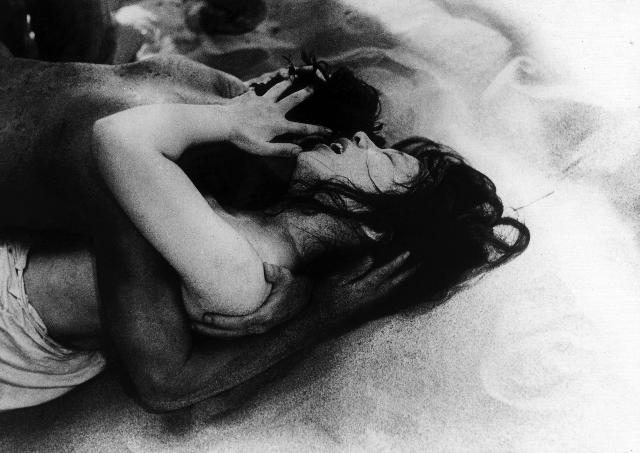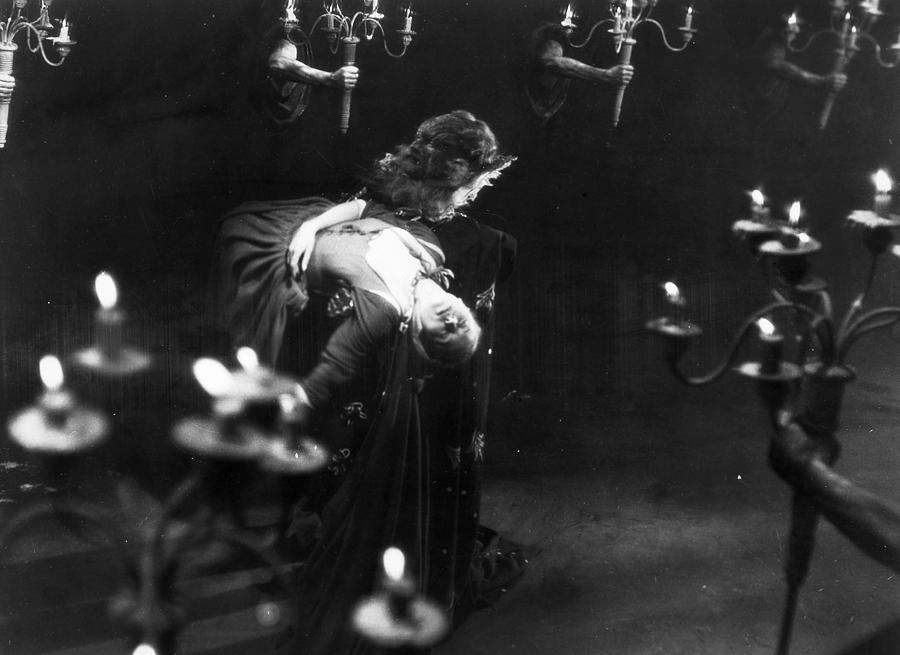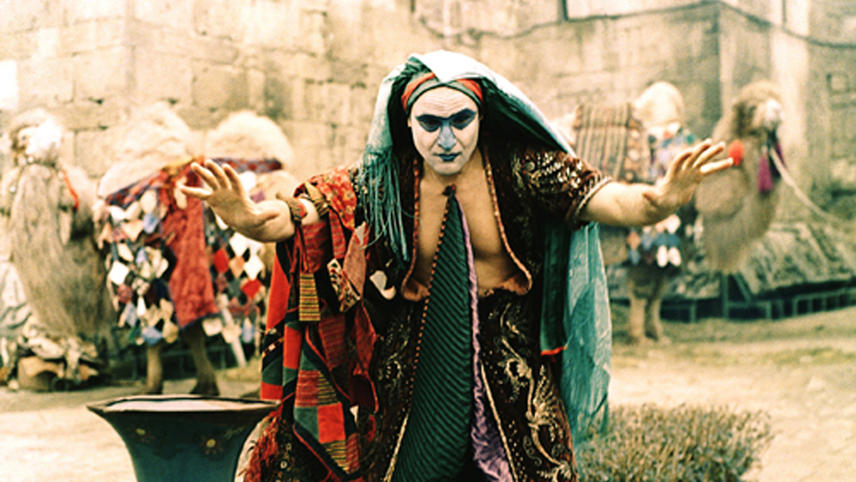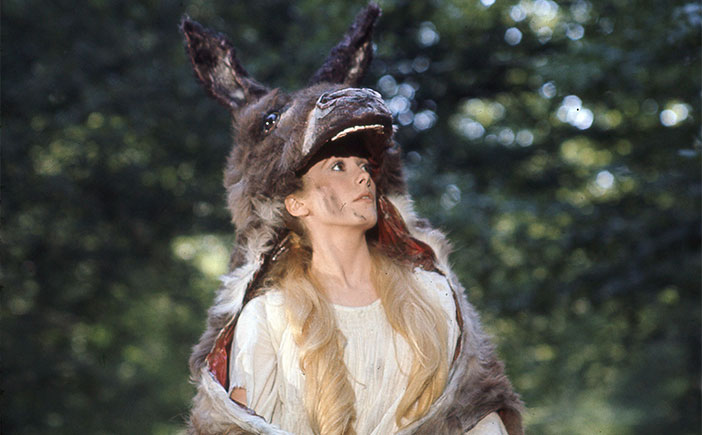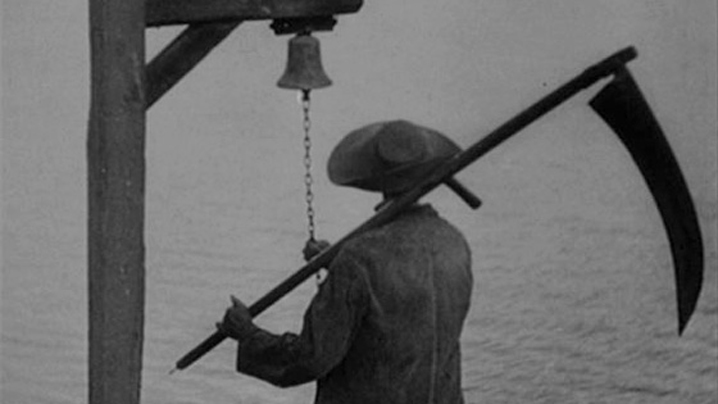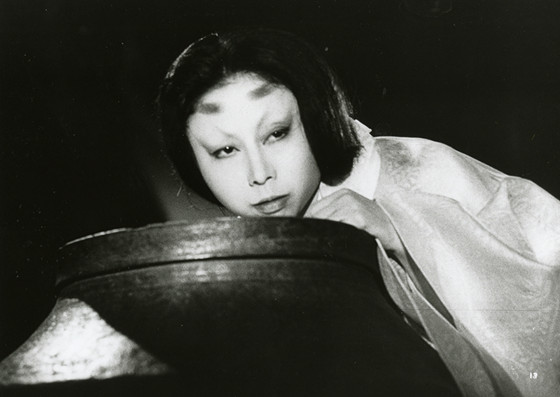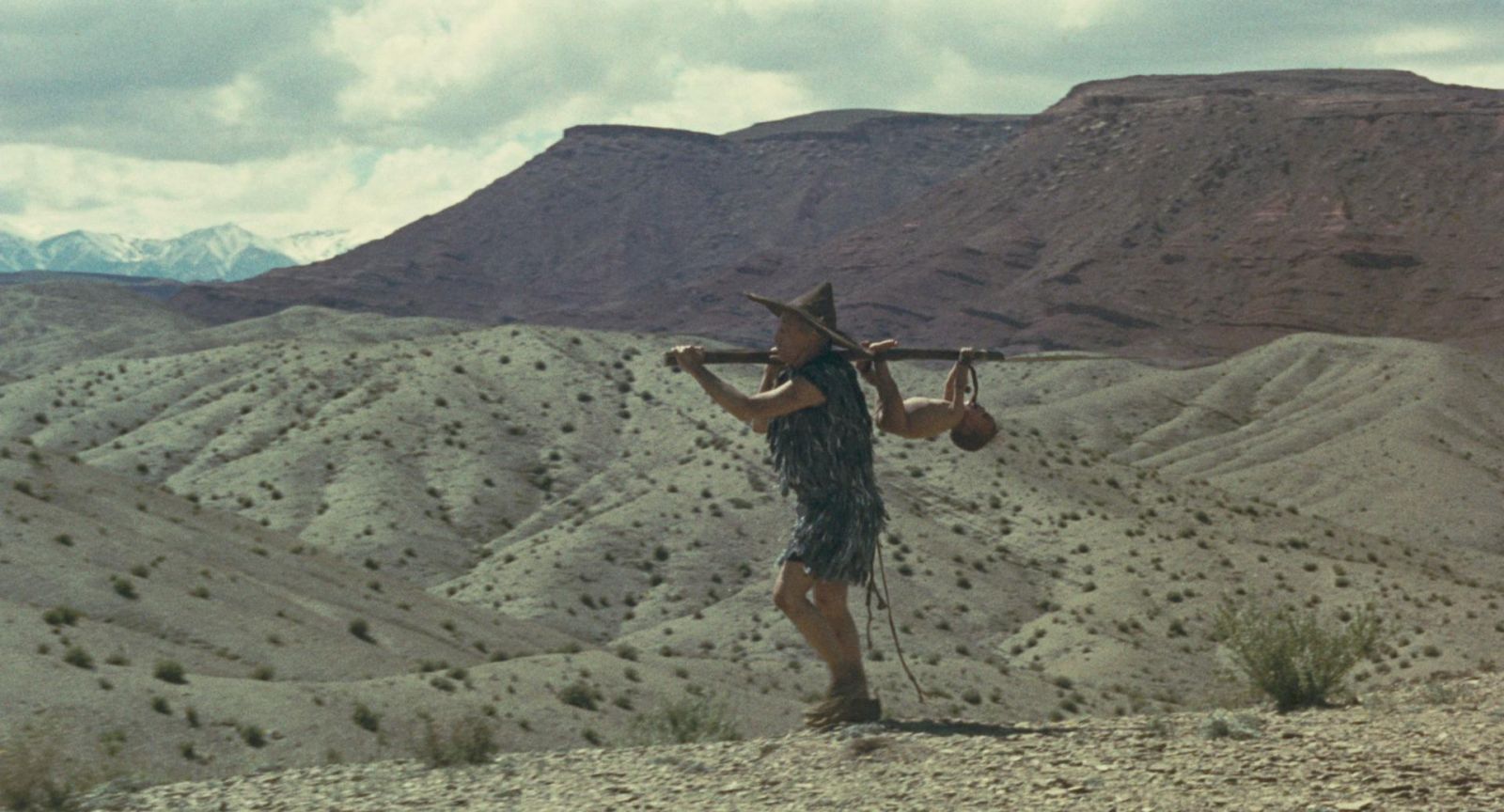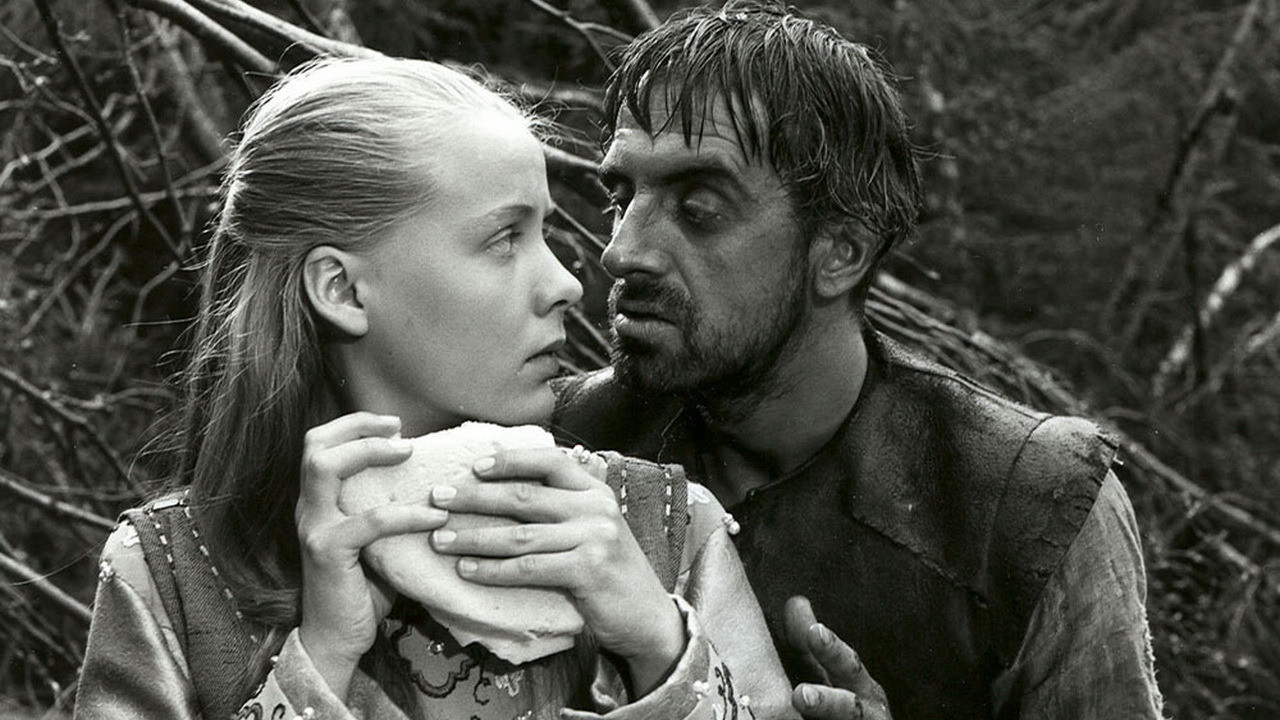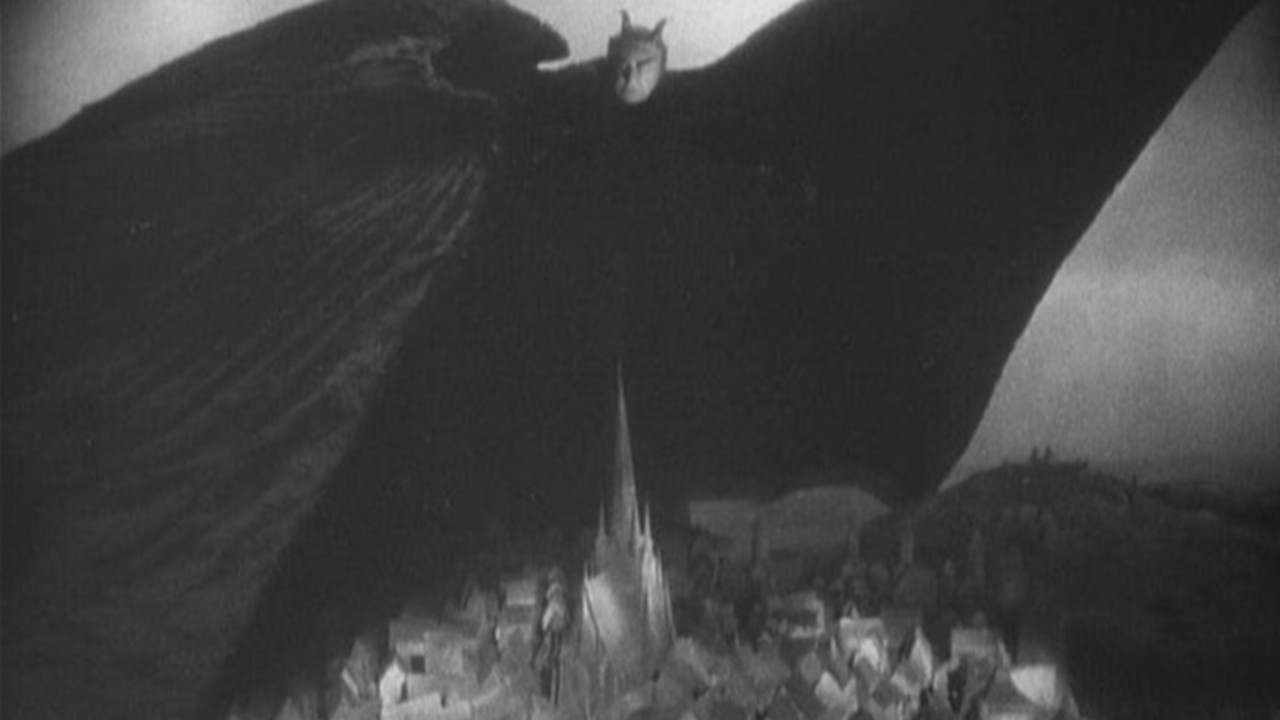17. Woman in the Dunes – 1964, Hiroshi Teshigahara, Japan
Woman in the Dunes is a modern-retelling of the Greek myth of Sisyphus, condemned by the gods to eternally roll a boulder to the top of a mountain, only to see it roll back down. Adapted from Kōbō Abe’s existentialist novel of the same name, the film tells the story of Tokyo schoolteacher and entomologist Niki, who after missing his last bus home from a remote stretch of coastline accepts the offer of a local villager to spend the night in a woman’s hut that happens to be located at the bottom of a deep sandpit accessible only by a rope ladder.
When Niki wakes the next morning, he discovers the ladder has been removed and that he is now trapped within the sandpit. Forced into sharing the task of shovelling the drifting sand that daily threatens to engulf them, Niki’s uneasy alliance with the woman gradually develops into a sexual relationship, and (in an echo of Camus’ The Myth of Sisyphus) Teshigahara’s film finally asks us to imagine this modern-day Sisyphus as happy in his labours, having found a purpose to his previously senseless existence.
Featuring exceptional performances from its two leads, astonishing tactile-like cinematography by Hiroshi Segawa and a minimal score by the experimental composer Tōru Takemitsu, the film won a Special Jury Prize at Cannes and, somewhat unusually for an avant-garde film, was nominated for two Academy Awards.
16. La Belle et la Bête – 1946, Jean Cocteau, France
One of the most popular stories in the fairytale canon, Beauty and the Beast can be traced back to the Greek myth of Cupid and Psyche, with variants of the story found in disparate cultures throughout the world.
Cocteau’s film is based on the best known version of the story, written by Jeanne-Marie Leprince de Beaumont in 1757: Belle, the youngest daughter of a merchant, offers to take the place of her father who has been sentenced to death for picking a rose from the Beast’s garden. But instead of killing her, the love-struck Beast commands Belle stays with him in his enchanted castle, where each night he proposes marriage to the young girl.
Although initially horrified, Belle gradually becomes more drawn to the Beast whose kind-hearted nature belies his fearsome appearance.
Cocteau is generally faithful to Mme. de Beaumont’s plot, but he transforms her rather insipid, pious parable about female virtue rewarded and the importance of seeing through appearances into something decidedly more morally ambiguous and erotically charged.
If these elements make La Belle et la Bête a fairytale for adults, Cocteau nevertheless wants us to view the film through the eyes of a child, invoking in the film’s prologue the classic fairytale opening ‘Once upon a time…’ (for Cocteau, ‘truly magical words’) as an abracadabra to childhood. What follows is not merely an interpretation of the fairytale, but a recreation of an entire fairytale world.
Some of the film’s magical elements are Cocteau’s own invention, such as the way the Beast seems to catch fire when overcome with emotion, but many are drawn from other fairytale portrayals: the depiction of the Beast’s servants, magically reduced to just their arms and hands, comes from Marie-Cathérine d’Aulnoy’s La Chatte Blanche; Belle’s tears which fall as diamonds from Charles Perrault’s Le Fées; while the set design, costumes and cinematography consciously evoke Gustave Doré 19th century fairytale engravings. But the film’s quintessentially Cocteauan atmosphere, as strange and beguiling as a dream, bears the author’s unmistakable imprint.
Somehow both earthy and ethereal, La Belle et la Bête is an utterly enchanting film. Jean Marais (Cocteau’s close friend and former lover) plays the role of the Beast alongside Josette Day’s Belle in what is probably Cocteau’s most loved film.
15. The Legend of the Surami Fortress – 1984, Sergei Parajanov, Georgia/Russia
Georgian-Armenian director Sergei Parajanov’s third film (his first after fifteen years spent in and out of the Soviet prison system on trumped-up, politically-motivated charges) is based on an ancient Georgian folktale about the construction of a fortress, which continually collapse under its own weight. The building seems doomed to failure until a fortune teller recalls a prophecy that will ensure its success – a young man must sacrifice himself by being immured alive within the structure.
The film follows Georgian writer Daniel Chonkadze’s 19th century version of the tale, but the plot (as with many of Parajanov’s films) is mainly a framework used by the director to hang his extraordinary images, presented in his trademark vivid tableaux style.
Like Alejandro Jodorowsky, a filmmaker Parajanov is sometimes compared to, it’s not always easy to fully comprehend what the director is driving at; but that imagery combined with an evocative soundtrack of indigenous folk music makes The Legend of the Surami Fortress a veritable feast for the senses. An astonishing film from one of cinema’s true visionaries.
14. Donkey Skin – 1970, Jacques Demy, France
The folktale of a princess who disguises herself as a donkey-hide-wearing scullery maid in order to escape the amorous attentions of her father dates back to at least the 15th century. Like Hansel & Gretel and Snow White, it’s one of those classic tales of child abuse.
Jacques Demy’s romantic fantasy musical follows Charles Perrault’s 17th century version of the classic fairytale in glossing over the story’s darker incest undertones – even if it does contain a song illustrating the ill-advised nature of father-daughter marriage with one of the most bizarre lines (‘But a girl with her father can expect nothing but tainted offspring’) ever to appear in a musical.
As that line suggests, Demy favours a humorous, tongue-in-cheek approach, and yet this never detracts from his film’s display of obvious affection towards the world of make-believe. It’s a charmed and endlessly charming film, with its bright colours, opulent sets and dazzling costumes creating the illusion of a storybook illustration magically brought to life.
Fittingly, the cast plays out like a who’s who of French film-star royalty: with Catherine Deneuve as the heroine princess, Jean Marais (cast in one of several nods to Cocteau’s La Belle et la Bête) as her overly-affectionate father and king, and Jacques Perrin’s charming prince providing the happily-ever-after ending. Academy Award-winning composer Michel Legrand contributes an enchanting score, but Demy’s classic is a film that even those with a pathological loathing of musicals can enjoy.
13. Vampyr – 1932, Carl Theodor Dreyer, Denmark/Germany/France
In his first sound film, Dreyer took a typically idiosyncratic approach to a vampire mythos that was already in the process of being codified by the success of Tod Browning’s Dracula (1931). Based on elements from Sheridan Le Fanu’s collection of supernatural stories In a Glass Darkly (mainly ‘Carmilla’ and ‘The Room in the Dragon Volant’), the film deals with a student of the occult who enters a vampire-cursed French village.
However, the plot of Vampyr largely plays second fiddle to Dreyer’s evocation of atmospheric dreamlike mood. With its otherworldly ethereal landscapes and oneiric imagery (rendered via a sfumato cinematographic technique achieved by shooting through gauze), it’s a film that stylistically has more in common with the surrealism of Buñuel’s L’Âge d’Or and Cocteau’s The Blood of a Poet (both released in 1930) than anything audiences had come, even by 1932, to expect from a horror film.
Perhaps unsurprisingly the film met with mixed reactions upon its release; its poor box-office performance and mostly negative reviews contributing to the collapse of Dreyer’s production company and the director’s subsequent nervous breakdown. Today hailed as a masterpiece of suspenseful horror, its influence can be felt everywhere from the dark dream-worlds of David Lynch to E. Elias Mehrige’s 1990 creation-myth horror Begotten.
12. Kuroneko – 1968, Kaneto Shindõ, Japan
Loosely based on the Japanese folktale ‘The Cat’s Return’, Shindõ’s supernatural horror is the story of a mother and daughter-in-law who return from the dead as vampire cat spirits intent on revenge after being raped and murdered by a group of marauding samurais. Events take a further tragic turn when the son returns from war and is ordered by the local magistrate to put an end to their reign of terror.
Although Kuroneko shares elements with its predecessor Onibaba (1964), Shindõ largely eschews his earlier film’s frenzied sexual energy for a more atmospheric, haunting eroticism. One of the most acclaimed films of the kaidan-eiga genre of period ghost stories, in lesser hands its central premise could have appeared silly.
Shindõ was then, though, an artist at the peak of his powers and Kuroneko builds towards an unexpectedly moving portrayal of the strength of love and familial relationships against the ties of duty while also functioning as a highly effective horror piece. The scenes in which the female spirits attack their samurai victims, combining extraordinary wire-work with Kabuki theatre-inspired imagery, are both terrifying and strangely beautiful.
11. Oedipus Rex – 1967, Pier Paolo Pasolini, Italy
The first part of the Italian director’s ‘Mythical Cycle’, Oedipus Rex is Pasolini’s appropriately dark and violent retelling of the ancient Greek tale of patricide and incest.
Apart from a Freudian-inflected prologue based on Pasolini’s own childhood and an epilogue where Oedipus is transported to present-day Bologna, the film is generally faithful to Sophocles’ version of the myth in which the eponymous foundling grows up to unwittingly fulfil the prophecy that he will murder his father and sleep with his own mother. There are some extraordinary costumes and an inventive use of masks, but Pasolini largely presents his tale as stripped bare as its Moroccan desert setting.
Pasolini favourite Franco Citti plays the central role with a belligerent intensity, well cast as the tragic hero made to realise the inescapability of fate and the terrible cost of knowing one’s self too fully. The eerily beautiful Silvana Mangano plays the prologue’s mother figure and Oedipus’ maternal lover Jocasta.
10. The Virgin Spring – 1960, Ingmar Bergman, Sweden
Based on the 13th century Swedish ballad ‘Töre’s daughters in Vänge’, Bergman’s film presents an even more terrifying vision of medieval Sweden than the one given in his better-known The Seventh Seal (1957). Combining elements of the original folktale with the medieval miracle or mystery play (as well as elements from the 15th century Middle English poem ‘The Three Dead Kings’), the film offers a deeply ambiguous examination of the power of faith in which pagan curses hold the same potency as God-authored miracles.
Featuring self-flagellating Christians, a tongue-less villain, and graphic scenes of rape and child-murder, it’s a litany of horrors all the more disturbing for Bergman’s cool, dispassionate approach. Bergman regular Max von Sydow plays the father who visits a terrible vengeance upon the rapist-murderers of his young daughter.
Winner of Best Foreign Language Film at the 1961 Academy Awards, the film would later inspire Wes Craven’s 1972 schlock horror The Last House on the Left. Bergman’s original, however, remains the infinitely more chilling picture.
9. Faust – 1926, F.W. Murnau, Germany
The centuries-old tale of the eponymous scholar who sells his immortal soul to the Devil for earthly gain has fascinated writers and artists through the ages, and filmmakers have been equally drawn to the story: István Szabó, Jan Švankmajer and, more recently, Alexander Sokurov, just a few to have given their takes on the legend. The definitive celluloid depiction of the tale, however, remains that of F.W. Murnau and his silent Expressionist masterpiece Faust.
The film draws partly on classic versions of the Faust story by Goethe, Gounod, and Marlowe, but is significantly more indebted to traditional folklore, as indicated by its subtitle ‘A German Folk Tale’. Murnau reduces the tale to an archetypal battle between the elemental forces of good and evil, with Faust caught in the middle as the demon Mephisto wagers with an archangel for the elderly scholar’s soul.
That theme is underscored by images of flickering flames, flashes of lightening and clouds of white smoke set against creeping, continually encroaching shadows which move across Expressionist sets designed by the same team that created The Cabinet of Dr. Caligari. If Nosferatu was a symphony of horrors (its subtitle), then Faust is Murnau’s magnificent symphony of light and darkness.
Featuring set-piece after set-piece of technical wizardry and virtuoso filmmaking – from its opening scenes of apocalyptic skeleton-horsemen and a towering Mephisto preparing to sow the seeds of plague over a medieval town, right through to the film’s fiery finale at the stake – even almost ninety years on it remains an awesome spectacle.
Faust was to be Murnau’s last German film before immigrating to Hollywood, and though neither a huge critical or popular success at the time (recouping only half of its then record 2 million mark budget), in terms of artistic achievement it is hard imagine a more impressive swansong.
